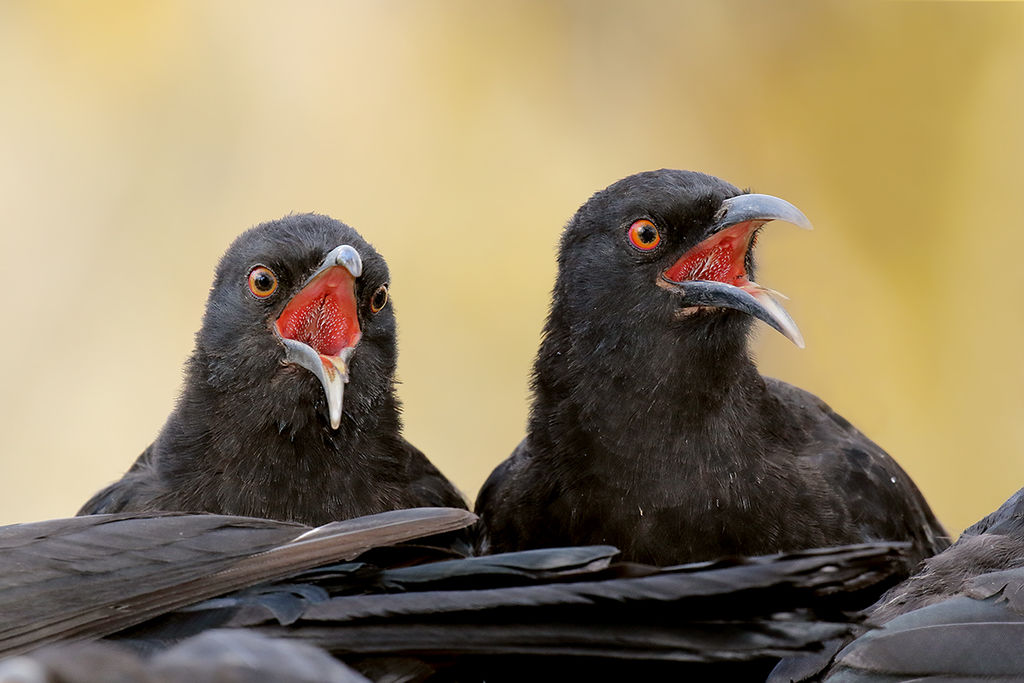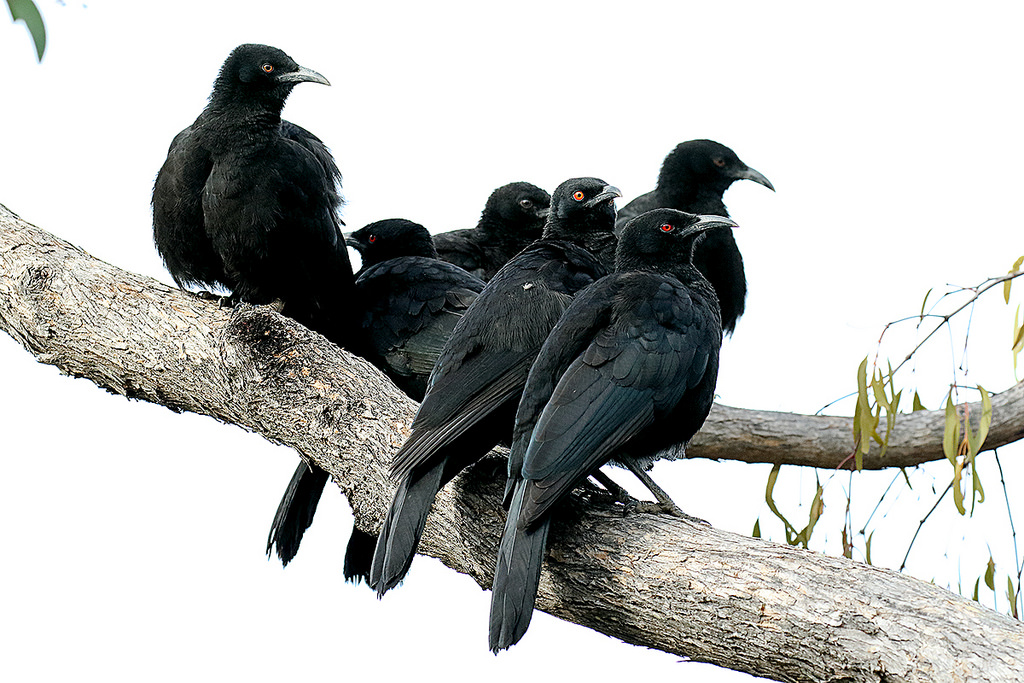Wheezing, whistling and whining – our two young White-winged Choughs have added to the usual cacophony of their family group this month. Their calls are similar to a young magpie, insistent and oft-repeated, but at a higher pitch.
White-winged Choughs are incredibly social, and because they spend most of their lives on the ground, very noticeable if you happen to have them on your bush block. They appear all black when foraging along the forest floor, flashing their white wing panels when they fly up to a nearby tree if disturbed.
Chough rhymes with “tough”, so it is pronounced the same way as “chuffed”! I am sure plenty of birdwatchers have used choughs in some bad bird puns…

Choughs doing what they do best – being noisy and weird! Photo by Patrick Kavanagh from Wikimedia Commons
Choughs also flash their white wings in an oft-used display known as the “wing-wave tail-wag” – used as a greeting to one another, and any interaction between adults and young. This display shows off all their best features – they spread their wings, fan their tails, fluff their back feathers, and often call loudly with a widely open beak. Best of all, the choughs bulge their bright red eyes in a literally eye-popping display that reveals the pink colour around their red irises.
Choughs and Australian Magpies seem to have some sort of ancient war going on – usually when there is a ridiculous amount of commotion coming from a little way off in the forest it is because a magpie is dive-bombing some unfortunate choughs.
But sometimes the tables are turned, and the choughs use their “wing-wave tail wag” display to full effect. They surround a magpie on the ground, and all display simultaneously, making themselves look very large and fierce. For some reason, this display is known as the “plum pudding” display.
I thought I knew a fair bit about White-winged Choughs, but when I turned to my trusty 11 volume tome known as the Handbook of Australian Antarctic and New Zealand Birds (HANZAB) I was blown away by how little I knew about the birds I have been literally sharing my garden with for 17 years.

Always in groups… Pic again by the awesome Mr Kavanagh
I knew that sometimes the choughs were here on my two hectare bush block every day for months, and other times only seen in the bush down the road. I also knew that I had one mud nest, built a few years ago in a manna gum by the southerly dam which is nearly always dry.
It turns out that White-winged Chough family groups have two types of territories, a breeding one that is between 10 and 50 hectares in size, and a non-breeding home range that can be up to 1000 hectares. When they are breeding, the family stay and forage within a few hundred metres of the nest. And seeing as our block is just two hectares– it looks like we are blessed with being not only in a breeding territory, but also a nest territory.
So, after the two noisy little ones are a bit older, the family will range more widely and even forage alongside the other chough families in the district. After doing a bunch of wing-wave tail wag displays, of course!
Choughs eat mainly invertebrates: spiders, caterpillars, centipedes, beetles which they probe and glean from the soil, leaf litter, bark, and low shrubby vegetation. They also eat fruits and tubers, such as orchid tubers. A family group is a minimum size of four, and up to 10 – and it takes a lot of insects and plant food to keep these large birds going.
In the early 1970’s a bird researcher, Merle Baldwin, studied the way choughs search for food on the forest floor, and it is completely mathematical in its precision!
“One feeding circle, described as 180m in diameter, involved 30 birds in four breeding groups. Birds moved in irregular lines of 6-8 birds in small anti-clockwise circles within a larger clockwise circle; small circles overlap leaving no ground uncovered. Four large feeding circles were completed each day”.
Furthermore, these foraging circles differ when the choughs are nesting.
“When a group begins building a nest, anti-clockwise movements inside a larger foraging circle become confined to within 90m of the territory boundary, leaving ~180 m around the nest untouched, which later provided a food source for the nestlings”.
What a fascinating bird! And I haven’t even reached the part which talks about kidnapping of young birds from other chough families, famously featured on a David Attenborough documentary several years ago…
Choughs – to be continued.
0 Comments